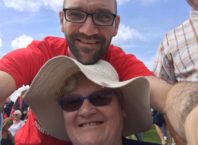This is a photo shot on the streets of Munich, Germany on 10th March 1933; just six weeks after Hitler came to power. The picture, published across the world and later in many history books, was a chilling portent of the hellish events that were about to consume Germany and much of the rest of the planet. Many have seen this photo, but few know the background behind it.
Dr Michael Siegel, an eminent 50-year-old German Jewish lawyer, is shown in the photo, bruised, barefoot, trousers ripped, being marched by Nazi ‘brown-shirt’ auxiliary police. The sign hanging from his neck was scrawled with the message, ‘Ich bin Jude, aber ich werde mich nie mehr bei der Polizei beschweren’ – ‘I am a Jew, but I will never again complain to the police’.
The day before this fateful photo was shot, the Nazis took over municipal control of Munich. A national emergency decree had just been passed to suspend ‘civil rights until further notice’, including the constitutional right to free speech, the freedom of the person, and the inviolability of a citizen’s property. In particular, Jews and Communists were targeted, and all Jewish lawyers were to be banned from practising or even entering the courts.
That day, Herr Max Uhlfelder, Jewish owner of Munich’s second largest department store that bore his family name, prepared to go to work as usual. His shop, owned and run by his family since 1878, employed around 1,000 staff and had some 7,000 square metres of sales space. A highlight of the store was the modern electric escalators that effortlessly transported customers up or down the three floors of this popular household and haberdashery store.
That day however wasn't usual, but what happened was to become usual in Germany under Hitler’s reign. Nazi Stormtroopers smashed the windows of the Uhlfelder store, and Max, along with 280 other Jewish Munich inhabitants, was taken to Dachau concentration camp for so-called ‘protective custody’.
Max’s wife, desperate to find help for her husband, phoned Dr Michael Siegel, their family friend and lawyer. Michael immediately made arrangements to attend Munich’s police headquarters to complain that his client’s civil rights had been violated. Next morning, Friday 10th March 1933, Dr Siegel, smartly dressed as usual, reached the headquarters at the appointed time. On entering the police station, Dr Siegel was told that he was expected and shown to a basement interview room.
However, once inside, instead of facing the usual police officer, Dr Siegel was confronted by a group of Nazi ‘Sturm Abteilung’ – storm troopers, who had been recruited as ‘auxiliary policemen’ by the newly appointed head of the Munich Police, Heinrich Himmler.
The burly men immediately unleashed a torrent of blows against the defenceless Dr Siegel. They knocked out some of his front teeth, perforated an ear drum, threw away his shoes and cut short his trousers. Blooded and bruised, a board was then hung from his neck bearing the notice that he was Jewish and would never again complain to the police.
Dr Siegel was then kicked out of the police station and made to march, barefoot and in his white “unterhosen” (underpants). The Nazi ‘police officers’, about seven in total, led him around Munich’s inner city streets, taking him on a circuitous journey, across Munich’s Karlsplatz (central square), and eventually ending up at the main train station.
On the way a few passersby looked on shocked, some stared with bemused curiosity, but others mocked and ridiculed, as Dr Siegel looked straight ahead, his eyes fixed, swallowing the blood from his broken teeth.
As the brown-shirted bullies arrived with their ‘captive’ just outside Munich train station, they ordered him to stand still. Then, drunk with derision, they loaded their rifles. One of the officers yelled, ‘Jetzt stirbst du, Jud!’ – ‘Now you die, Jew!’ The storm troopers then scornfully laughed, about turned, and left.
Fortunately, a vacant taxi was nearby. As Michael Siegel was about to get in, a man approached him. In an English or American accent, he said that he’d taken a photo, and could he have permission to publish it? Dr Siegel said yes, then got in the taxi and asked to be taken home to 10 Possartstrasse in the Bogenhausen area of Munich.
At home was his daughter Beate, looking forward to her 8th birthday party in just four days time. She had stayed home in bed that day with a cold. When she heard the key in the front door, and footsteps entering the apartment, she thought it was her mum coming back from shopping. Strangely, she didn't come to see her.
Beate thought something must be wrong. She got up and saw her father’s tattered and blood drenched clothes hanging on the hooks outside the bathroom. It was a huge shock, and she couldn’t have any idea what had happened. She knocked on her parent’s bedroom door, and hesitantly opened it, but her father had pulled up the eiderdown to hide his pale, bruised and blood stained face.
‘Wait till your mother comes home,’ he said in a pained voice. Beate realised that something truly awful had happened.
Mathilde Siegel later told Beate and her 12-year-old brother, Peter, an outline of what had happened to their father, but not the full detail. Eventually, Dr Siegel recovered from his injuries, and didn't have to recover his pride or dignity, as those he had never lost. Over the next few years before the start of the war, he tried many times to practise law again, but being Jewish in Nazi Germany, that was made impossible.
Look again more carefully at the photo of Dr Michael Siegel being marched along the streets of Munich by his Nazi tormentors. This was a man who was shockingly brutalised, and came home bloodied and bruised and awfully betrayed by his country. But despite the shock of being demeaned in such a disgusting way, his head is still high as he walks barefoot along the streets of Munich, those brown-shirted Nazi thugs goading him along. The Nazis were eventually beaten into submission, but not Dr Michael Siegel. With his wife in 1940, they escaped the Hitler dictatorship by taking a trans-Siberian train across the Soviet Union to Japan from where they embarked a ship to Peru, which they made their new home.
Years later Dr Siegel was asked what was going through his mind as he was being beaten and then forced to march across the city? He replied that he was thinking, 'I’ll survive all of you.' And so he did. Dr Siegel lived to 97 years, and enjoyed 50 years of marriage with his wife, Mathilde.
What happened to the shop owner that Dr Siegel tried to save? Max Uhlfelder remained incarcerated in the Dachau concentration camp with his son, where many were severely brutalised and several died. In the ‘Kristallnacht’ Nazi attacks on Jewish properties across Germany in November 1938, his department store was ransacked, set on fire and its doors left open for several days. The store was later ‘confiscated’ by the Nazi regime.
In January 1939, some eight months before the start of World War II, Max and his son were released from Dachau, and the family managed to obtain a visa to India, guaranteeing their survival from certain death if they had stayed in Germany. Before leaving Germany, they were stripped of all their assets and even made to pay for the repairs of their ruined department store.
What about Peter, Dr Siegel's young son? By 1939, with world war imminent and attacks on Jews and their property becoming more brutal, sinister and murderous, it was obvious that Germany, which had been the home and nationality for hundreds of years of Siegel ancestors, was no longer safe. With the help of his dad, Peter then aged 18, managed to get a student visa to England on strict condition that he left when his studies were complete. War changed that condition. He joined the British Army and after the war England became his ‘adopted’ country. Peter became an expert in minerals and metals, and managing director of a successful multinational company based in London.
And Beate, what happened to her, the young girl whose 8th birthday was never to be what it was meant to be, dark clouded by the savage attack against her dad and his unforgettably shocking and bloodied homecoming?
Well, this week I met the daughter of the man in the photo that alerted the world to the terror of the Nazis.
Bea, as she likes to be known, is a wonderful octogenarian who survived the Nazis and who also sought refuge in England and made it her home. Together on Wednesday evening, we sat and watched the remarkable documentary in which she features, ‘The Children Who Cheated The Nazis’, at a special showing of the film at The Wiener Library in London.
The documentary was produced in 2000 by compassionate film makers Sue Read and Jim Goulding, and first aired on Channel Four. It tells the story of how, in the months leading up to World War II, around 10,000 mostly Jewish children were rescued from Nazi Germany, Austria, Poland, Czechoslovakia and the ‘free city’ of Danzig, by coming to England unaccompanied on a series of special trains and boats known as the ‘Kindertransport’.
There were strict conditions. The children were not allowed to stay in England permanently, and their parents were not allowed to travel with them. For the children, and their parents, it was to be the most heart-wrenching separation of their lives. Most of the children never saw their parents again, as they were later murdered by the Nazi regime.
To be allowed into England, each child required sponsorship of £50, an enormous amount back in 1939, and a family to look after them. Huge efforts were made to save as many children as possible, and the British public raised half-a-million pounds towards the rescue effort. When war was declared less than a year after the Kindertransport mission started, the Nazis wouldn't allow any more children to leave.
With her parents help, Bea , then aged 14, managed to be selected to join one of the children’s ‘freedom’ trains, soon after her older brother Peter had also made his escape to England. At midnight on Monday 26 June 1939, Bea joined several other bewildered and tearful children on the platform at Munich train station. As steam bellowed from underneath the train, and the Nazi soldiers sharply separated the youngsters from their heart-broken and often unsure parents, Bea climbed the steep steps onto the train. With just one small suitcase, all she was permitted to take, Bea joined a compartment full of other children, not one adult amongst them, apart from the stern and disapproving looks of Nazi officials and guards.
Through the train windows the children and parents frantically waved each other goodbye, none of them knowing when they’d be with each other again, none of them realising that almost all of them never would.
Through the midnight hours, away from the daylight gaze of publicity, the Jewish children’s train made its long 550 mile night journey north across the heart of Nazi Germany, through Nuremburg, Frankfurt and Cologne, over the border into Holland, and a waiting boat to England from the Hook of Holland. Bea was sponsored by an elderly English non-Jewish widow, and later studied modern languages at the University of London. Like many of the kinder children, who had no choice, Bea settled in England. She married twice, has three sons and six grandchildren, and became a magistrate.
Bea, and her brother Peter, did see their parents again, but never again did they share the same family home together. The documentary in which she features, ‘The Children Who Cheated The Nazis’, is an accurate and carefully reported account that deserves much wider viewing. It’s true that the children of the ‘Kindertransport’ cheated the Nazis out of slaughtering them, which for sure the Nazis would have done if these youngsters had stayed behind. But the Nazi regime also cheated these children out of the childhood, family, and future that they should have had.
Bea told me she feels lucky. Luck of course is relative. She, her brother Peter, and her parents Michael and Mathilde, were lucky to find liberation from the Nazis, as was store owner Max Uhlfelder and his family. They were the ‘lucky ones’; the few who ‘got away’, because most, the vast majority, didn’t manage to escape as they did. Yet this ‘relative luck’ came with the price of losing their family life; their savings and belongings; their country of birth, and their relatives and friends who were left behind and perished.
So it’s a luck tinged with a gnawing sadness of what might have been, and an abiding anger towards the brutal nasty Nazis who were so blinded by their flawed fascist ideology. Bea, with language that’s necessary but which also belies her sweet gentle nature, has no hesitation in calling those Nazis, especially the ones who bashed up and tried to belittle her dad, 'the shitty bastards'.
Ten thousand mostly Jewish children were saved from death in the Holocaust by being transported just-in-time to the relative safety of England. It’s a wonderful story and needs to be told to countless future generations. But it should also be understood that those ten thousand rescued children amounted to less than 1% of the total number of children murdered by the Nazis and their collaborators. Around 1.5 million completely innocent children were callously annihilated because people were poisoned by an idea that this was the right thing to do. The same virus of a belief also drove previously civilised Europeans to slaughter and or subjugate millions of innocent adults during those years of vile fascist power.
To understand this history and to avoid its recurrence, we have to know the antidote to the virus of hate and abuse and intolerance. Often, the virus starts slowly and in small ways, and only spreads and grows when people say and do nothing.
In Nazi Germany, one of the first acts of government was to ‘suspend’ laws protecting human rights. That’s something we must guard against ever happening again.
In response to the appalling atrocities of the Nazi regime, the United Nations adopted the Universal Declaration of Human Rights on 10 December 1948. Two years later the Council of Europe drafted the European Convention on Human Rights, which came into force on 3 September 1953.
In addition, respect for human rights is an essential component of all European Union treaties and are reinforced by the European Union's Charter of Fundamental Rights.
These are vital, precious declarations that need to be cherished, preserved and upheld. An act of inhumanity against one human, any human, is an act against all humanity.
Original source – http://jondanzig.blogspot.co.uk/2013/09/the-photo-that-alerted-world.html?m=1
Find the author here – https://www.facebook.com/jondanzigwrites
#UnityMarchUK
If you like our content please consider helping us to take back the media
https://www.gofundme.com/UnityMarchUK




